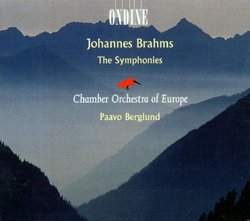| All Artists: Johannes Brahms, Paavo Berglund, Chamber Orchestra of Europe Title: Brahms: The Symphonies Members Wishing: 0 Total Copies: 0 Label: Ondine Release Date: 9/25/2001 Genre: Classical Style: Symphonies Number of Discs: 3 SwapaCD Credits: 3 UPC: 761195099025 |
Search - Johannes Brahms, Paavo Berglund, Chamber Orchestra of Europe :: Brahms: The Symphonies
 | Johannes Brahms, Paavo Berglund, Chamber Orchestra of Europe Brahms: The Symphonies Genre: Classical
|
Larger Image |
CD Details |
CD ReviewsA Brahms cycle to make you forget all others! MartinP | Nijmegen, The Netherlands | 02/05/2002 (5 out of 5 stars) "Here are the Brahms symphonies like you've never heard them before, and after listening to this I wondered if I actually ever had heard them before. What Berglund and the COE bring to this music sounds so completely right! It's all very lean, extremely transparant and totally stunning. Any notion of Brahms as the composer of stolid, heavy, mushy music is swept away. The clarity of the inner voices reveals the continuous rhytmic activity and drive underpinning these scores, something that is alas almost never heard in recordings, and is so thrilling when properly brought to the fore. The relatively small string sections allow due prominence to the winds, every single line clearly audible, yet without the nusic becoming overly detailed or fussy. Nor is there any lack of feeling: Berglund and his team can sound utterly romantic, dreamy, mysterious or exciting/excited when they choose, and they do, in all the right places! Berglund is clearly very well aware of the structure of the music and knows which points to highlight, sometimes revealing snatches of important themes in places where you'd never heard them before. The playing of the COE is of the very highest order. First and second violins are placed opposite each other, resulting in some titillating dialogue. The recording itself is very clear and natural, and though it was made 'live' in concert the audience must have been stunned into silence, because you would never guess it's there. In general, a Brahms cycle nobody who loves this music should miss! I can imagine no more perfect readings of the second and third symphonies; and if in the first and fourth I sometimes missed just that very last ounce of sheer weight and power, even there the insights on offer are so numerous and fascinating I wouldn't want to do without them either." A new view of Brahms David MacFarlane | Philadelphia, PA USA | 02/02/2002 (5 out of 5 stars) "These recordings are revelatory. Berglund has clarified the textures of the symphonies so details previously hidden come out. Horn and woodwind parts that in other hands have been somewhat lost in the mix sing out. The structure of these symphonies is revealed in new ways and new interconnections have been laid out. I LOVE THESE! My only objection is that the first two discs are skimpy, about 44 minutes each. I know that this is a 3 disc set for the price of two, but couldn't the Overtures or the "Haydn" variations fill out each disc? Small matter. Buy these, they are TERRIFIC!" Wonderful Wayne A. | Belfast, Northern Ireland | 10/04/2005 (5 out of 5 stars) "What's great fun is laying these out alongside the Mackerras set or Harnoncourt's--both fine examples of the new (and much welcome) revisionist Brahms performance style. Mackerras is lean too but a bit more traditional, Harnoncourt is like listening to Schoenberg--yet not a note is different. I found his set even more revealing than these, a lot of inner detail was there that was just extraordinary.
Passionate Brahms is great too and I can't live without my Furtwanglers but I don't find this set dry at all. I especially enjoy straight-up Brahms with a truly great orchestra. Few may agree but the Concertgebouw with Haitink is still, for me, the best blend of the various sounds one can get from Brahms. The orchestral playing is about the most beautiful I've ever encountered and his set with Boston is almost as good. Funny how these new recordings make many earlier ones sound muddy in comparison and how that criticism was once leveled at Schumann (Brahms has also been accused of being a poor orchestrator). If this is how the Brahms symphonies sounded back in his time then the schism between him and the Wagner circle seems much more understandable--the contrast is much less obvious when we hear, say, Klemperer or even Karajan perform Wagner and Brahms. Maybe this is the truly correct way to hear the music? Oh, an afterthought: Brahms leaner may not be as overtly passionate (I think here of the cartoon character Pepé Le Pew) but when you hear all that inner detail the music's a lot sexier. " |

 Track Listings (4) - Disc #1
Track Listings (4) - Disc #1